How come when I posted the list of hidden gems, no one said, “what the heck, 5 stopovers with Asia Miles?” Why haven’t I posted about it yet? Make sure you at least read about the single airline award chart.
The truth is, the program is new to me, but my eye was caught. I started thinking about and testing some routes. Like a flight to Easter Island would likely run 85,000 miles, which seems like a lot…
But then consider that you can stop at all the places in that picture for the same price. And Easter Island is usually priced as a pacific island and is near that price anyways! But at the same time, distance based programs favor those who are closer end, like Miami. A similar trip (cutting out Santiago (not my fav anyways)) starting from Miami would cost 65,000 miles!
Not bad at all. So let’s get into the award chart and rules. Despite not having experience with the program it is similar to ANA in many ways and we’ll make our best guesses based on the rules printed.
Transfers
So you can always earn by attributing OneWorld flights to Asia Miles and SPG transfers to pretty much everyone… but, Amex also transfers to Asia Miles.
And the reality is, how many good transfer options do you have with Amex MR anymore? Aeroplan? British Airways? I hate to say it, but there aren’t a ton. There is not an obviously superior transfer option, like Chase UR to United. Instead, there are a bunch of unknown programs that have hidden gems within their programs. Asia Miles could have many.
Pricing
It’s a little confusing but basically there are two award charts. One for flights that include Cathay (and possibly one other partner) and one that includes OneWorld partners. We’ll focus on this for now.
OneWorld Multi-Carrier Award Chart
Conditions:
- Roundtrip
- Two OneWorld airlines that don’t include Cathay or DragonAir; OR
- Three or more OneWorld airlines when Cathay or DragonAir is included
- Price is calculated by miles flown
- “You can make a maximum of five stopovers, two transfers and two open-jaws at either origin, en-route or turnaround point, subject to airline partners’ terms and conditions.”
- I believe you have to return to the same country but not same city.
That’s all the info we need I suppose.
Sometimes the price is actually better than some of the award charts and sometimes not. But to figure it out, we have to look at total distance flown, just like I talked about in the Best Use of ANA miles post.
Here we’ll need to calculate distance flown by using a distance mapper like this. I also prefer to use the OneWorld route map here. With the map I figure out possible routes and then calculate the total distance, which can be used with the above award chart to figure out the price.
Any one of the connections can be used as a stopover. So if I go from JFK to Zurich then to Madrid and then back… That’s 8,291 miles, thus costing 60,000 miles. While that particular route isn’t extra awesome, you still have stopovers to spare.
Since the Amex transfer options aren’t abundant, I’d say 60,000 miles is good for multiple stopovers, assuming you fly on airlines that avoid fuel surcharges.
Award Chart Goodies:
Europe
First Class to Europe for 105,000 miles to 155,000 miles. With some stopovers it could be as high as 190,000 miles. But it would be western USA to Eastern Europe.
For example, JFK to LHR and back in AA First Class would be 105,000 miles. Worth it for such a flight? Don’t know. But for a little bit more you can go from the middle of the country to the middle of Europe with stopovers along the way.
Houston with stopovers in New York, London, Istanbul, Vienna, and Paris for only 155,000 miles for first class. It’s 85,000 miles for economy, which is a little high to me, but still not a bad Amex transfer option.
If you can avoid fuel surcharges, it’s a decent deal.
South America
As shown above, it could be a great way to do South America as LAN is a great OneWorld partner with no fuel surcharges. However, shorter flights like the Caribbean hopper would not only have to route through Miami, it would just be much more expensive than using Avios.
But the odd thing is that this is one of the only distance based programs that is terrible for short hauls. A 0-1,000 mile trip starts out at 30,000 miles for multi-carriers. And we’ll talk about the other award chart in a second.
This means that trips to Easter Island are hot spots on the award chart. However, to get this price talked about in the beginning, you need to have two OneWorld airlines. This means that at least the first or last leg should be on AA. This means routing through MIA, DFW, ORD, JFK or possibly LAX.
That being said, a South American lover (like my friend Ed) could visit 5 places in South America for 65,000 miles or so. This is pretty darn good although you’d have to compare with British Airways Avios as they have pretty darn good options for South America as well. Except you may get over charged if you need to connect multiple times with British Airways Avios as they charge per segment. (Read the Best Use of British Airways Avios).
Either way both are OneWorld partners that are transfer partners of American Express. And 65,000 miles is regularly had by a sign up bonus. And as much as I would benefit from pushing a credit card sale right here… the Amex bonuses are really low at the moment. Sometimes they go up to 75,000 miles, even if only for a day. So, I’d wait.
If you are thinking of a big South American trip, again, use the OneWorld map to map out a trip and then price it with GCMap. It shouldn’t have to be in a hub (like LIM, SCL, and EZE), it could also be a connection between the places. Like you could fly to Rio on AA and then continue you onto a LAN hub like Santiago.
Piece together a trip and then price it out.
Might as well do one right here, eh? So I pieced together DC to Rio (via Miami), to Santiago, to Easter Island, to Lima, to Quito, then back to DC (via Miami). This trip covers a lot of ground and is over 15,000 miles pricing it at 90,000 miles. That’s more than I was expecting but unless you are doing Miamia to Lima area, it’s hard to stay under 10,000 flown miles (for a price of 65k).
That trip comes out to be 90,000 miles with 5 stopovers across South America, including Easter Island. How does this compare with Avios?
Well let’s use Wandering Aramean’s Avios tool. Know that it only calculates one connection so I’ll do DC to GIG, then GIG to IPC, etc… One connection at a time.
Oh, and even if you’re not using Avios, this will give you connection ideas. Like I could connect in Dallas. But anyways, it’s saying those first two segments are 32,500 Avios (BA miles). To IPC for 22,500; (for whatever reason it didn’t calculate Easter Island to Quito propertly so I used the GCmapper); to UIO for 20,000; and back to DC for 17,500 Avios. Total = 92,500.
I’ll be derned, that’s close. But I will say, you still have more wiggle room with Asia Miles. You still have 3,000 flyable miles left and then the next price jump is only 5,000 points. So for most people Asia Miles is actually cheaper for South American trips. Although I’d still compare.
The only winner of Avios is that you can have as many stops as you want as you are paying by segment. So you could stop in Miami if you wanted to as well… but with Asia Miles, you’d be out of stops. Just a thought.
Round the World
The long distance awards aren’t bad for a distance based program. It wouldn’t normally be so high on my list, but this means more options for stopovers.
An around the world trip would likely be 130,000 miles (190k/275k for biz/first). Like the one below:
Dublin, Amman, Delhi, KL, Sydney and/or Hawaii… Okay that’s one too many stops. As I assume 5 stopovers (similar to ANA) includes the “destination”. Obviously taking out Sydney would shorten the trip a lot. So this could be a huge option for someone with more time.
Single Carrier & Cathay Award chart
*UPDATE* Jeff (CanadianKilometers) pointed out the terms and conditions say that price is based on oneway distance.
So if you are wanting to fly to Hong Kong on Cathay, Chicago to Hong Kong would be 7,793 miles. This means for a roundtrip, it would be 90,000 miles and for a oneway it would be 55,000 miles.
So here is when you would use this award chart:
- If you fly on one partner carrier; or
- Fly Cathay (or DragonAir) and one other partner
Also know that only two stopovers are allowed for this type of redemption. And one stopover for a oneway.
For example, a oneway from Chicago to Madrid is only 25,000 miles and 45,000 roundtrip. Eastern USA and western Europe are generally going to be 45,000 miles roundtrip on this award chart, which isn’t bad at all!
But for even shorter flights, I don’t think it can ever beat Avios.
Things to Consider
I know it seems like a lot, but just piece together your trip and look at it on the multi partner award chart and then compare it using the British Airways Avios tool.
If it’s a single airline, or two including cathay, you’ll use the second award chart. And again, check with British Airways Avios.
I think for some flights to Europe and most flights to South America, this will come out as the best option for Amex Transfers. Aeroplan has a flat 60,000 mile price to lower South America, which may turn out to be better but Asia Miles will more than make up for it with stopovers.
South America, some Europe flights, around the world flights, and anything you feel would be worth having 5 stops. Again, I think stopovers probably means any stops at all with them.
I know people are sometimes intimidated by thinking about a new program, but just check the award chart, and think about if it will save miles first. If not, don’t worry about it. But either way, it’s all the same: transfer the miles, look up availability on a OneWorld search tool (like Qantas’ award search site), and then call to book. That’s it.
I hope this overview of Asia Miles pricing and their stopover rules was helpful, if not now somewhere down the road.


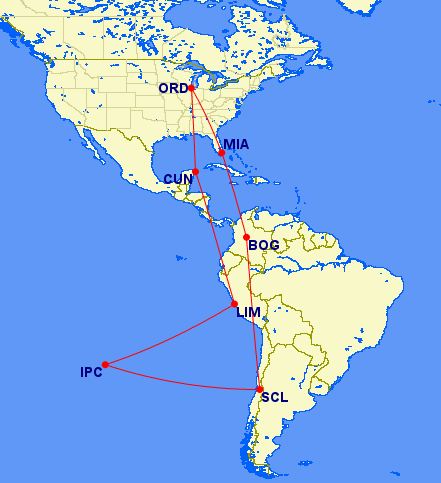
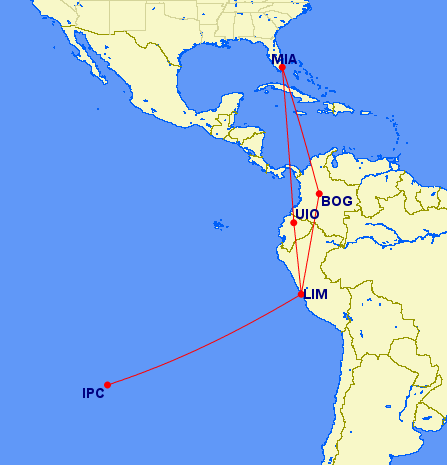
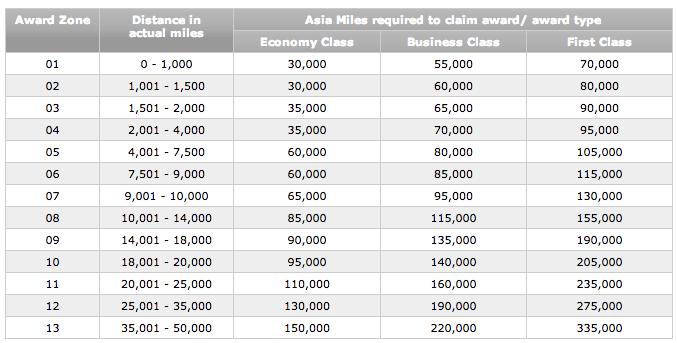
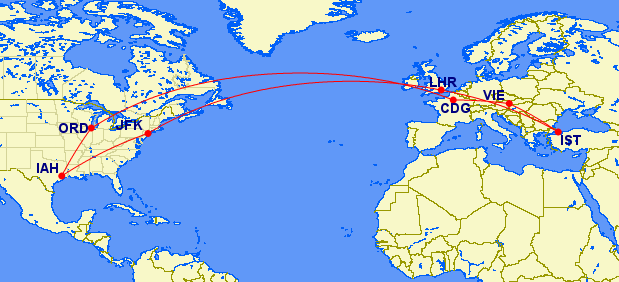


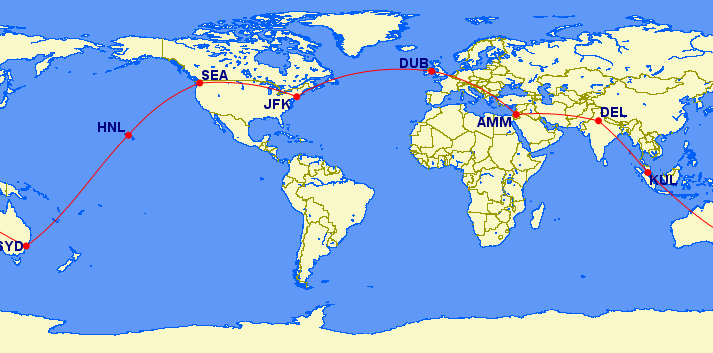





Thanks for the info. Very helpful. How about fuel surcharge in this program? Have you tried to piece an award together with the agent, and if so what was your experience? Can you have the reservation in place before transferring the miles?
I think this is an almost great post, lots of information and great research here. What keeps it from being great is the lack of fuel surcharge information! But I understand we can’t expect to be spoonfed on every single details 🙂
Cathay charges fuel surcharge on almost every carrier except for flights operated by AA if I’m not mistaken (unless if your award originates in Brazil)
Similarly, ANA also charges fuel surcharges for every carrier except on flights operated by US and UA
Man… That is such a good point Anh.
And similarly, good questions Shalling! Tonight, I’ll go back and add a section on booking.
So let me say this until I add it. You can not hold tickets. There is no fee for booking over the phone. I get the feeling that the phone agents aren’t used to people booking award. 😀
As far as fuel, it’s charged on all the OW partners that have fuel. And it’s similar to what you would find if you broke down the fare on ITA or used BA, except yes, no fuel surcharge on international AA flights (BA does add I believe).
Your posts make me wonder if there could be a huge benefit in a collaborative tool to decipher the cost efficiencies of award programs. You do a great job of showing us how we could play around with itineraries to find savings, but what if there was a tool that we could all plug into, all build upon.
I’m a total newbie, so maybe my thought is obvious and has already been fully considered. Nonetheless, it is a model that has proven to be wildly successful in many other endeavors.
I think there is a website that considers the price of all the major programs… I think. If not, it should be done. I have a series of posts coming up that will break things down to make it easier.
Surely that information could be automated though. But to understand you right, kind of like the Avios tool mentioned but for every airline?
I was thinking more along the lines of how we could help you map these things out. You seem to play around, and very successfully, with the airlines and the hotel programs till you find some real gems. What if you could delegate certain tasks out – be a force multiplier?
Maybe I’m just such a newbie that I am asking obvious questions that have already been answered.
I honestly have no idea what of it can be coded and what can’t. I suppose if you can load all the routes of an alliance. And give basic calculations for routing rules… well at the very least you could have something show you the price and ideas. No idea though really lol, I’m no techie.
Is the LIM-IPC route back? I remember LAN discontinued it as it wasn’t filling up very well, indicating that it would bring it back as a seasonal flight but that didn’t occur this year.
Oh I didn’t know it went away. I flew it last year in the summer. Guess, this is since then?
Great article. I have 35000 Asia Miles which will expire at the end of Oct 2013. Can you suggest what would be the best way to use them for travel in North America? Thanks.
Where are you starting from?
And I am new to your website and enjoy it very much. I wanted to concur that it would be great if you have the time to publish a chart of the international carriers that due charge the fuel surcharges when redeeming miles with them. Or as someone else mentioned, we could pool from our combined knowledge. I just flew here to Thailand on Korean Air, and yes the charged ($500) for fuel surcharges. Such is their “free” ticket. Thank you.
Thanks Benjamin.
I’ll try to organize my info and publish it in the future. Anything to help people avoid these goofy fuel surcharges, really.